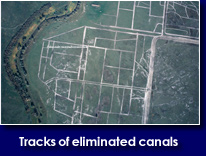| |
| |
 Natura
2000 is a Europe-wide ecological network of sites hosting natural values
of European interest. The habitat type of pannonic salt steppes and marshes
is a priority one on the list of habitats of Community importance, targeted
for urgent conservation measures. Hortobágy is the largest coherent occurrence
of this habitat type in Europe. Natura
2000 is a Europe-wide ecological network of sites hosting natural values
of European interest. The habitat type of pannonic salt steppes and marshes
is a priority one on the list of habitats of Community importance, targeted
for urgent conservation measures. Hortobágy is the largest coherent occurrence
of this habitat type in Europe.
The LIFE project was implemented on the territory of the Hortobágy National Park, which is part of the Natura 2000 network as proposed Site of Community Importance under the Habitats Directive and has been designated Special Protection Area under the Birds Directive. |
 The
Hortobágy National Park was established in 1973. It covers more than 80,000
hectares from which 52,000 ha is UNESCO Biosphere Reserve. The entire
area is World Heritage Site and almost 24,000 ha is protected by the Ramsar
Convention. The national park area is dominated by alkaline grasslands
extending over vast territory (the largest coherent natural grassland
in Europe), interspersed by varied wetland habitats. Continuous, natural
grassland covers 54,000 ha. The
Hortobágy National Park was established in 1973. It covers more than 80,000
hectares from which 52,000 ha is UNESCO Biosphere Reserve. The entire
area is World Heritage Site and almost 24,000 ha is protected by the Ramsar
Convention. The national park area is dominated by alkaline grasslands
extending over vast territory (the largest coherent natural grassland
in Europe), interspersed by varied wetland habitats. Continuous, natural
grassland covers 54,000 ha. |
|
Mineralogical and quaterpaleontological data of the last 30.000 years prove unambiguously that the formation of salinised areas here is not a result of human activities. |
| |
Alkaline steppes of the project area
were damaged by the intensive agriculture practice of the 1950ies with
building of grassland irrigation systems and rice-systems. These unused
and abandoned infrastructures have fragmented the native grassland, altered
the characteristic surface micro-topography of the area and forms an obstacle
to local run-off. As natural processes (surface water movements) maintaining
originally the alkaline steppes and marshes are blocked by these structures,
continuous degradation proceeds.
 The
water management installations of unused paddies and irrigation systems
are very good hiding-places for foxes and the dike systems offer good
place for burrows. On the project area the fox is the most significant
factor responsible for low reproductive success of Great Bustard. The
water management installations of unused paddies and irrigation systems
are very good hiding-places for foxes and the dike systems offer good
place for burrows. On the project area the fox is the most significant
factor responsible for low reproductive success of Great Bustard.The project aims at eliminating those artificial factors causing degradation, hereby to restore the biological diversity of grasslands, ephemeral waters and marshes. This is the only possibility to ensure long term conservation of flora and fauna of this priority habitat type. |
|
|
|
|
|
Download project brochure and
laymans report in PDF file.
|